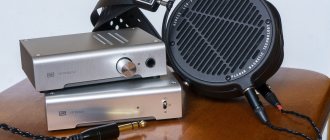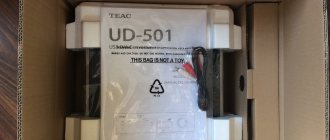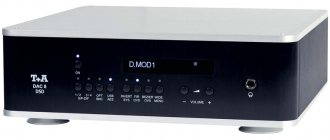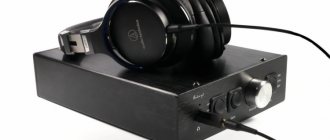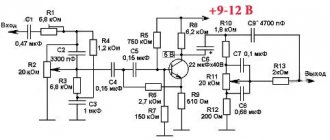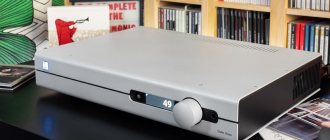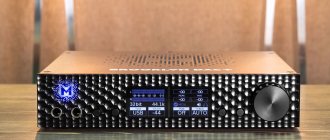So, we continue our study of Schiit equipment, which began with the ultra-miniature Fulla DAC/amplifier. His review attracted a considerable number of comments. They discussed not only the company's products, but also the cultural roots of the name of the young American company. This time I will try to concentrate as much as possible on the performing abilities of the subjects. Fortunately, there is a lot to talk about here.
But you still can’t do without irony - after all, Schiit is Schiit. The title of the material, for example, is inspired by the first line from the official description of the Modi 2 Uber DAC, which sounds like this: “Honey, I’ve shrunk the Bifrost.” Bifrost is the next oldest multibit DAC with a much more impressive size and price tag.
Magni and Modi are half-brothers, sons of Thor from the giantess Yarnsaxa and the fertility goddess Sif.
And just a little bit of Scandinavian mythology: Modi and Magni are the sons of Thor and brothers, and accordingly, they cannot avoid close proximity to each other.
Made in USA
This is exactly the proud inscription that appears on the board of Schiit Audio components.
But the most important thing is that this inscription reflects the whole essence of the device, because not only the assembly, but also the circuitry is original. What am I going to tell you, you already know enough about Schiit Audio from our previous publications. Let's focus, perhaps, on a couple of components that will be discussed today. This is a Magni 2 headphone amplifier and a Modi 2 USB DAC. The names are familiar, aren't they? So we at the editorial office were pretty puzzled when we received an offer to test them, because we had already talked about a couple of devices with such names. However, Magni 2 and Modi 2 are different. In the previous test there were improved versions, Magni 2 Uber and Modi 2 Uber with expanded functions and slightly different circuitry. Now it’s come to the basic versions, which have one very significant advantage - they are obscenely cheap. This couple will not take up much space and will fit even on a fairly cluttered table
In the Schiit Audio line, this pair ranks right after the more compact USB DACs Fulla and Fulla 2, designed for laptops and mobile devices. Thus, we have a minimum set of equipment that makes sense to install next to a desktop computer. According to Schiit Audio, of course.
An updated version of the Schiit Magni headphone amplifier has been released in two versions
Schiit Audio has released two versions of the entry-level headphone amplifier: the traditional Magni 3+ and the experimental Magni Heresy op-amp model
The new Magni 3+ and Magni Heresy headphone amplifiers are compact entry-level desktop models. Magni 3+ is built using fully discrete current-feedback circuitry, delivering the highest performance of anything Schiit Audio has ever produced. Magni Heresy implements the exact opposite circuit principle - all its stages are assembled on the basis of operational amplifiers, thanks to which it was possible to achieve the best performance in terms of measurement results. Both amplifiers are manufactured in-house in California, USA, feature all-metal cabinets and deliver twice the output power of any other entry-level headphone amplifier.
“The Magni 3+ is essentially an acoustic amplifier shrunk down to a headphone-friendly size,” said Jason Stoddard, co-founder of Schiit Audio. “It is superior to the previous Magni 3 thanks to a new output stage and a Vbe multiplier that reduces distortion by 10-15 dB compared to all previous Magni. At the same time, we were interested in how much we could improve the measured parameters using modern operational amplifiers. As a result, our Magni Heresy surpasses even the new Magni 3+ in terms of distortion.”
Both Magni 3+ and Magni Heresy combine extremely low distortion with class-leading high power output. Both units deliver 2.4W RMS into 32 ohms driving two channels simultaneously with less than 1% distortion—about twice as good as any other headphone amplifier in their class and better than any Magni ever released to date. . As a result, the operating noise level is so low that it cannot be heard even on sensitive in-ear monitors. This unique combination of high power and low noise makes the new Magni 3+ and Magni Heresy ideal for virtually any headphone setup.
“To be honest, these are not entry level amps at all,” Jason added. “You simply won’t need anything better than them, regardless of whether you use tight planar headphones or ultra-sensitive in-ear monitors”
Magni Heresy got its unusual name (Heresy - English - Heresy) and non-standard black and red coloring because it is radically different from everything Schiit has done before, following its dogma of as-discrete-circuitry as possible. Despite this, the result was so good that it was decided to add both versions of Magni to the “Thunderdome” device community.
Thunderdome is a new production concept introduced a few months ago. It allows Schiit Audio to sell experimental, unusual and special products in small quantities. Those devices that become the most popular and in demand will be included in the permanent assortment.
“This approach allows us to produce products that no one would have seen before, for example, Magni Heresy.” Jason said. “Now we’ll see what our customers like best: a completely discrete amplifier or an amplifier on microcircuits. They will literally decide the future fate of the new Magni, not us.”
Like other Schiit Audio devices, the Magni 3+ and Magni Heresy are designed and assembled in California from components manufactured primarily within the state. For example, their cases are manufactured in Valencia, and their printed circuit boards are manufactured in Simi Valley.
Both models will go on sale in January 2022 with an estimated retail price of RUB 12,000.
Discuss on the forum
PC only
With a USB DAC, it all starts with the USB receiver. This detail, according to some experts, has a very significant effect on the overall sound quality. The Modi 2 uses the CM6631 chip from C-Media. Most people familiar with computers associate this manufacturer with budget sound cards, but that’s what Schiit is all about, to surprise with unconventional, but always effective solutions. This particular chip is far from the most budget-friendly, and it was chosen solely based on its characteristics and quality of work, without regard to its origin.
Rare minimalism. But everything is logical: power from a USB computer does not require a switch
Next to the USB port on the device body there is a switch marked S and E - “Standard” and “Expert” modes. Translated into numbers, the switch gives a choice between connecting with an audio stream resolution of up to 24 bit/96 kHz to work without drivers with any device, including mobile devices, or with a resolution of up to 24 bit/192 kHz, but with the need to install drivers. However, the latter applies exclusively to Windows. Other Mac and Linux users don’t have to worry about this, because in these OSs the DAC is detected without any drivers in any mode.
A mysterious switch near the USB port allows you to connect to Windows without drivers
After the USB receiver in the signal path comes the AKM AK4490 converter from the Japanese manufacturer Asahi Kasei. And at the output we will find an operational amplifier chip AD8616 from Analog Devices, even more understandable to fans of classical audio, precision thin-film resistors and film capacitors (no electrolytes in the signal circuit). This part is quite consistent with the canons of Hi-Fi. And the device housing is, in fact, a small desktop Hi-Fi. They are noticeably heavy and massive. Manufacturers clearly did not spare metal, and even the volume knob is aluminum, not plastic.
USB C-Media converter provides high-quality sound if prepared correctly
If you read the specifications, the main differences between Modi 2 and Modi 2 Uber come down to the presence of optical and coaxial inputs in the latter. At the same time, the difference in price is quite noticeable: the Uber version is one and a half times more expensive, and if you are not going to use SPDIF inputs, decent savings emerge.
But if you take a closer look, you can see one important fact: Modi 2 is powered by a USB cable, while Modi 2 Uber is powered by an external linear power supply. I suggest you just remember this fact for now. In the meantime, we'll move on to the amplifier.
Mighty Babies
Two boxes, almost identical in size, are stamped from a fairly rigid steel sheet and decorated with rough-polished aluminum overlays, which act as top covers and front panels. Winged metal is the privilege of devices labeled Uber (in German - a superlative degree or the upper position of something).
In addition to the finishing, the Modi 2 Uber differs from the base model in the presence of optical and coaxial SPDIF inputs and an external power supply, which allows you to avoid all the delights of receiving electricity from a computer. Magni 2 Uber (unlike its ordinary brother) is equipped with an adjustable output to the final amplifier and selected pairs of transistors in the amplification path. Its power supply is external, and judging by the weight of the adapter, there is a powerful transformer inside.
The volume control button and knob are also machined from aluminum
Modi 2 Uber is built on a 32-bit dual-channel AK4490 DAC manufactured by Asahi Kasei Microdevices. This chip is interesting because it has five different types of digital filters with the ability to turn them off completely, as well as support for digital streams with sampling rates up to 768 kHz on PCM and DSD up to 11.2 MHz. The device itself accepts tracks up to 24 bit/192 kHz via any of the three inputs, and 24-bit streams at frequencies of 176 and 192 kHz are reproduced without oversampling. But keep in mind that not every source is capable of producing a signal with such characteristics via optics.
As for DSD, Schiit devices traditionally do not support native playback of single-bit streams, since the main developer of their digital subsystems, Mike Moffat, considers the simultaneous implementation of PCM and DSD a compromise that is harmful to the sound.
The USB port is clearly implemented on Mike's favorite low-jitter C-Media CM6631A controller; analog summation and active filtering are carried out by a precision Analog Devices AD8616 op-amp, as well as circuits of thin-film resistors and high-precision film capacitors.
Power adapters are similar in size and weight to the main units
An important point: if you connect Modi 2 via USB to a Windows computer (regardless of the newness of the operating system), it is quite possible that they will not find a common language without outside help. “Come to your senses, Microsoft: the USB Audio Class 2 protocol was developed ten years ago,” the Schiit developers cry on their website and there they also distribute the drivers necessary to solve this problem. By the way, Android devices fully support this protocol, although I could not find official information about which OS version this friendship begins with. One way or another, my Sony Xperia Z5 Compact smartphone with the USB Audio Player Pro application installed saw the DAC with a bang. The pair also connects to the iPhone without problems, but provided that iOS version 8 or 7 is installed on it (a Lightning/USB adapter, of course, will also be required).
The developers honestly warn about the incomplete compatibility of Modi 2 with Chromebooks on AMD processors, but it seems to me that the owners of such machines are unlikely to care about the problems of choosing an external DAC.
In conjunction with a smartphone, the system works without problems. It’s a pity that audiophile USB-OTG adapters are not yet visible
With the Magni 2 Uber amplifier connected, everything is much simpler. In addition to a line input and a quarter-inch headphone jack, the device is equipped with an adjustable output for connecting to an external power amplifier. This, by the way, is an important difference between the Uber modification. In addition, this version is equipped with a more impressive power supply (the capacitor capacity in the anti-aliasing filter is increased from 4000 to 6000 uF) and an amplification path that is improved in almost all respects.
Essentially Magni 2 Uber is a class AB transistor amplifier with DC feedback. Free from coupling capacitors in the signal path, it is assembled exclusively on discrete elements.
One for all
The Magni 2 amplifier is another example of brevity, which will also cost one and a half times less than the older, improved version of Uber. It has one RCA input and one output. That's all. The role of a preamplifier is not expected, so Magni 2 has one task - to amplify the sound in headphones. I would like to note right away that the headphones can be anything - from standard low-power “plugs” purchased to work with a smartphone, to a solid high-impedance High End.
Bend and paint a thick sheet of metal and you've got a cabinet for a neat desktop amplifier
To control the impedance, there is a switch on the back wall labeled “hi” and “lo” (high and low, respectively). The power figures are very respectable: 1.8 W per channel at 16 Ohm load and 130 mW at 600 Ohm. With all the intermediate stops: 300 Ohm headphones will get a quarter of a watt, and a typical 32 Ohm impedance for portable headphones will allow you to get 1.2 W of power. In a word, Magni 2 is not much weaker than the Uber version and you won’t be spoiled under its control either.
External power is connected on the back side and the gain is adjusted
The amplifier has class AB circuitry and is assembled entirely using discrete elements. Transistors are used both bipolar and field-effect. The feedback is fixed in depth throughout the entire frequency range. This approach made it possible to obtain good channel separation, a high signal-to-noise ratio and a low level of distortion.
Everything is honest inside: a couple of transistors and no microcircuits in the power amplifier
The power supply is linear, which is a kind of corporate standard for Schiit Audio. The developers are convinced that a switching power supply for audio devices is, in principle, not applicable.
Schiit Modi 2 Uber external DAC and Schiit Magni 2 Uber headphone amplifier
This time we are testing equipment from a brand that is not yet well-known, but the very first mention struck a nerve: Schiit. Even more surprising was the size of the devices and the large “Made in USA” inscription. When I found out about the price, the question arose: maybe it’s true that “Shit happens”? Maybe anything really can happen and it’s possible to design and produce devices with good Hi-Fi sound within this budget?
I think anyone can find the history of the name on the Internet if they wish, and the idea of organizing the production of Hi-Fi equipment not in China, and selling it directly, only through their own website, belongs to two American engineers, former developers of large audio brands. They believed that producing audio equipment in the USA would be faster, cheaper and of better quality. Well, I can’t wait to check whether it worked or not.
Schiit Modi 2 Uber DAC
Characteristics (more details on the manufacturer’s website):
- Input Receiver: C-Media CM6631A (USB), AKM 4113 (S/PDIF)
- DAC: AKM4490
- Analog Adder and Active Filter: AD8616
- Outputs: RCA
- Frequency range (at ±0.1 dB): 20 Hz - 20 kHz
- Harmonic distortion (20 Hz - 20 kHz): Intermodulation distortion: Signal-to-noise ratio (unweighted): >104 dB
- Nutrition:
- Dimensions: 127×89×32 mm
- Weight: 0.45 kg
As already noted, the device surprises with its small size, but there is no discrimination in switching. Onboard inputs: USB 2.0, optical (Toslink), coaxial (RCA), and all interfaces support up to 24 bit/192 kHz. The power supply is impressive in size and weighs more than the device itself. The body of the device is entirely steel (an L-shaped cover is attached to the chassis). There is one button on the front panel that sequentially switches 3 inputs and 3 moon-white LEDs to indicate the selected input. The power switch is located at the back; given such a miniature size of the device, this does not cause any inconvenience.
Schiit Magni 2 Uber headphone amplifier
The device has the same dimensions as the DAC, and since the overall style of the cases is meticulously maintained, the devices look great in pairs.
Characteristics (more details on the manufacturer’s website):
- Frequency range (up to −0.1 dB): 20 Hz - 20 kHz
- Output power (RMS) per channel at: 16 ohms: 2.1 W
- 32 Ohm: 1.5 W
- 50 Ohm: 1.2 W
- 300 Ohm: 0.32 W
- 600 Ohm: 0.16 W
Amplification class - AB, the circuit is built on field-effect/bipolar transistors, with a constant feedback depth throughout the entire audio frequency range, all stages are DC coupled. On the front side there is a jack for connecting a “large” 6.3 mm headphone plug, a rotary analog volume control and the same LED as on the DAC, only in the singular - it lights up when the amplifier is turned on with the toggle switch on the rear panel. There is also a gain level switch on the rear panel: Hi/Lo. For high-impedance headphones it should be set to the Hi position. I would especially like to note the presence of not only an entrance, but also an exit. In this way, you can organize a through channel and avoid connecting cables. For example, turn on the amplifier between the DAC and the preamp and use it as needed. When headphones are connected, the output is de-energized. During testing, the Modi 2 barely got warm, while the Magni 2 got hotter, but within reason.
Subjective sound assessment
Stationary system
- sources: computer with Twonky software server, laptop with Foobar player
- DACs: Schiit Modi 2 Uber (AKM4490), ClassicVoice (TDA 1541), ClassicVoice (CS4398), Yamaha NP-S2000 (2×PCM1792)
- transport: network player Yamaha NP-S2000
- amplifier: Musatoff PA-20
- acoustics: Arslab Classic 1, Sonab B32, KEF Xq40
The transport is connected via Ethernet to the router and receives digital data from a DLNA server installed on the desktop. The DAC receives the digital stream from the transport via S/PDIF (coaxial). I start warming up with rock. The sound is open, direct, energetic - I like it. I move on to other genres: jazz, jazz-rock, blues, blues-rock, classical. After a long listening session, I note that the Schiit Modi 2 Uber sounds balanced, there are no obvious complaints about its sound - contrary to the initial prejudice against a DAC the size of 2 packs of cigarettes. In addition, in previous tests, some unpleasant features in the sound of the devices under test appeared in the very first minutes of listening.
But the test would be incomplete without comparison with other devices. Unfortunately, there were no solutions of similar price at hand for comparison. I alternately connect the original ClassicVoice multibit on the TDA 1541 and the original ClassicVoice DAC on the CS4398 to the transport. 3rd option - I send a signal to the amplifier from the built-in Yamaha NP-S2000 DAC (2×PCM1792). It should be noted that the prices of the devices being compared are 2-4 times higher than those of the tested DAC. Only in comparison with a multi-bit DAC do I begin to notice a certain simplification of the sound on rich tracks; on jazz at high volumes, sometimes I want more softness on the wind instruments, and in classical music, more intelligibility at the highest frequencies and less harshness in the bows. I'm not sure that it would be possible to distinguish delta-sigma DACs of even higher price from the Schiit Modi 2 Uber tested.
Headphone path
- headphone amplifiers: Schiit Magni 2 Uber, Musatoff 5SE
- headphones: Sennheiser HD700
Since we are also testing a headphone amplifier, a great idea arises: compare our DAC with others, connecting them one by one directly to a headphone amplifier. This way it will not be possible to fully test the difference in the construction of the stage, but the influence of the room and the frequency response of the speakers is completely removed. Fortunately, headphones with smooth sound are available - Sennheiser HD700.
I immediately notice how easily the amplifier drives high-impedance headphones. The dynamics and elaboration of the entire frequency range down to deep bass are excellent; There is a volume reserve.
All the sound features of the Schiit Modi 2 DAC noted when listening to a large acoustic system can also be heard through headphones. Rock goes with a bang, more sophisticated and complex genres sound quite detailed, dynamic and comfortable, and only when compared with a multibit DAC do I notice a slightly greater roughness in the sound of the Schiit DAC.
Let's move on to connecting via the USB interface. The source used was a desktop running Windows 7 with the Foobar software player, as well as a laptop running Windows 10 + Foobar. The sound compared to connecting the DAC to the transport via S/PDIF is very similar - it’s not a fact that it can be distinguished in a blind test. When listening for a longer period of time, I note that on complex genres the sound is a little harsher than I would like. There were no differences in sound when receiving a digital stream from a desktop or laptop.
The logical question is: what impact does a headphone amplifier make? I'm unpacking a headphone amplifier, mass-produced by a Russian audio manufacturer. The size of this device is 3 times larger, and the price is twice as high. You will have to repeat all the “exercises” again. I switch all the DACs one by one to the new amplifier.
The difference between the DACs remained at the same level, which indicates sufficient transparency of the amplifier for Schiit headphones; he doesn't hide nuances. On rock, the difference in presentation between amplifiers is almost imperceptible, but you can already say for sure that it exists. Schiit Magni 2 Uber sounds a little harsher, but that's good for rock. When moving to more complex genres, you can hear that the more expensive amplifier sounds a little more intelligent and soft, but this difference is only audible if you listen specifically. During normal listening, the Schiit Magni 2 Uber sounds quite intelligible, energetic and balanced.
Separately, I would like to specify these “legible”, “energetic”, “sharp-soft” on specific tracks that were used in this testing. For regular listening without reconnections and comparisons, music of many styles was used for two weeks, and it was Schiit devices that were connected to the system. For comparative listening, we mainly used tracks from the disc “2010 - “Quick On The Fly Tests” Absolute Sampler”. Everyone can check at home.
Can-can
: the scale and dynamics of both Modi 2 Uber and Magni 2 Uber are at their best. Towards the end of the track you can hear violins, sounding as if on top of the main action and very quiet relative to the other instruments. Multibit allows you to hear the vibration of the sound of violins (you have to listen). The Modi 2 Uber has a less pronounced vibration, sometimes merging into a uniform, very high note. At the same time, this feature also appears in other DACs that took part in comparative testing. This difference can be heard when connected to any of the headphone amplifiers. When listening on acoustic systems, in my case this difference in the sound of DACs is leveled out.
Libertango
: the initial strikes on the keys (apparently an accordion) have different volumes and intensity on all tested devices, but the nuances are sometimes different. When listening at high volume levels through the Magni 2 Uber, the tutti on the accordion sometimes takes on a loud character. The worst case scenario was with a USB connection. On all DACs, the sound sometimes resembles a mosquito squeak, and only on multibit can the “body” of the instrument be heard. On the other hand, multibit embellishes and fattens the sound, so it is not entirely clear which is correct.
Brombo
- an excellent track for testing the dynamics and naturalness of sound. The Schiit devices performed just fine, without any discounts - both the DAC and the amplifier. Very driving, percussion is crumbly, no disadvantages compared to the more expensive tested devices.
More general notes on the sound. It would seem: if sometimes you can hear harshness in the sound of both the Schiit DAC and the amplifier, then when they work in pairs, this effect should double. But this doesn't happen. Together, the result is a package that is no worse in detail than more expensive Saber devices - and without the super-detail inherent in some of them, which is tiring. The sound has openness, detail, and energy that are important for rock, pop and electronic music. It's balanced. If you listen to more complex genres, especially classics, it makes sense to take a closer look at Schiit devices of a higher level. There are all the prerequisites for obtaining a good result in the next price niche. However, during the testing period I had no desire to turn off and replace the devices; their sound is comfortable in any genre at a volume level almost to the maximum, and this remark was made based on the results of comparison with devices that are several times more expensive.
Conclusion
Based on the results of three weeks of testing, it was possible to understand that the Schiit Modi 2 Uber DAC and the Schiit Magni 2 Uber headphone amplifier are a balanced combination in terms of sound, switching capabilities and exterior. The sound of the devices has not fallen victim to miniature size and low price. Among the disadvantages, we can note the need to install a driver on the computer for a USB connection to the DAC and the downside of miniature: when connecting hard cables, the device can stand “on tiptoes” due to its low weight.
Selection of tools
A fairly wide range of headphones were used for testing. I had with me bassy Tonino Lamborghini Quantum HL-01 headphones with a dual speaker and Tonino Lamborghini Spectrum One SE Studio on-ear headphones, which, unlike the serial version, have a well-balanced frequency response. In the Schiit Audio showroom, Beyerdynamic DT-770, Sennheiser HD700, as well as OPPO PM-1 and PM-3 were waiting for me. Not every High End can be approached with such an arsenal, but here, as you can see, you are lucky. And this, by the way, is completely justified. To understand how bad or good a system of this class is, it is best to take several headphones of completely different prices. This is how the limits of the components become most apparent.
A large number of different headphones increases the objectivity of the assessment
Let's start right away with the conclusions. The set copes well with in-ear, inexpensive on-ear or full-size headphones and provides noticeably higher quality sound than the same stereo phones with a smartphone, laptop or computer provided. It makes sense to raise the quality class of headphones to approximately the ORRO RM-3 level. You will be satisfied with the sound of the OPPO PM-1 or Sennheiser HD700 only if you have never listened to these models in a more expensive system before.
How do you like this audio still life? I think it's cute!
During testing, I, one way or another, used the entire arsenal, and for everyday use of Magni 2 and Modi 2, the optimal solution would be headphones whose cost is comparable or slightly higher than the cost of the set. It is important that the amplifier copes very confidently with completely different models, so the choice will be quite wide.
Finding cables can be a problem, because even short wires are redundant for these kids.
Another specific point that I would like to highlight from the very beginning is the choice of USB cable. I had at my disposal two versions of the SOtM Audio USB cable with copper and silver conductors. They are, of course, somewhat expensive for such a system, but it was interesting to determine the DAC’s response to replacing cables. It turned out to be very noticeable. Copper simplified the sound a little and made the sound of the double bass booming; on silver veins, the booming practically disappeared, and the detail was noticeably higher. Therefore, I want to pay special attention to this fact. Changing the cable can be a means of improving sound quality or changing its character.
From bass to treble
One of the first things that definitely pleased me and demonstrated the superiority of the Magni2 over cheaper alternatives was the control of the bass range. In this regard, the Tonino Lamborghini headphones became the most revealing. Both models are quite demanding on the amplifier's capabilities, and if there is not enough power or damping factor, the bass sound becomes booming and uncontrollable. The Magni2 demonstrated excellent bass control even on challenging content such as the Arctic Monkeys' AM album. There were no problems with the other headphones either, and only on the Beyerdynamic DT-770 the bass was a little boomier and blurred at low notes, which, however, was not annoying and was perceived rather as a specific sound of these headphones.
You can safely experiment with the selection of headphones, but within reasonable limits
Further comparisons with portable devices and standard headphone outputs seemed, frankly, pointless. The kit was better in all respects, but that is precisely what it was created for - to rise one or more degrees of quality above standard solutions.
The stage is wide, indicating good channel separation. Riding with the King didn't try to bunch up inside the head; instead, Eric Clapton and B.B. King were located somewhere in the ear cups. Enya's recordings conveyed the space and atmosphere of the recording very well. The resolution that this set provided made it possible to experience the audiophile benefits of Dire Straits recordings, although it did not bring out absolutely all the details. But the dynamics were simply excellent! This was felt well on Alex Clare and other energetic music, including hard rock and simple metal. Dance and pop music sounded very good, especially energetic and bright things (like Sia's albums), and Michael Jackson's hits demonstrated some kind of incredible articulation of vocals and clarity of rhythm - I didn't even think that these qualities could feel redundant.
It’s difficult to expect big and high-quality sound from this pair, so the small Schiit is especially surprising
In general, the set paints a sound picture with large strokes characteristic of the American sound school, while being very rhythmic and bold, which makes any recording, even of low quality, seem very expressive. When listening to low-quality masterings, the result was very pleasing. The compression is audible, it is clear that the detail of the recording is low, but the musical part suffers minimally from this. You can listen to any quality content, even MP3, without discomfort. Attention is focused not on defects, but on the artistic component. This property is very relevant, because from a computer we play not only Hi-Res recordings, but also listen to Internet radio and streaming services that cannot boast of a high bitrate. And music videos on YouTube have not been canceled.
Honest approach
Taking this opportunity, I compared the Magni 2 and Modi 2 kit with the closest models from the branded line. The difference with Fulla 2 was very obvious. Both in controlling complex headphones and in overall quality indicators (resolution, range and dynamic characteristics), the Magni 2 and Modi 2 were clearly better. Well, the result is quite expected. I expected a much less significant difference from replacing Modi 2 with Modi 2 Uber, but here it definitely made itself felt. Detail has increased, the sound has become more focused, clear and voluminous. The step forward turned out to be more than significant to consider the difference in price justified. It's a pity that Magni 2 Uber was not at hand. It would be interesting to compare.
And I would like to end with a slogan: choose high-quality headphones!
In general, the experiment showed that the positioning of Schiit Audio’s products in the line is very fair, and the cost of the devices is truly worth every ruble.
